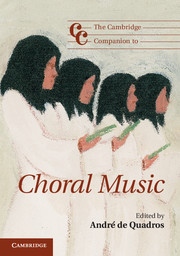Book contents
- Frontmatter
- 1 Introduction: choral music – a dynamic global genre
- Part I Choral music: history and context
- Part II Choral music the world over
- Part III Choral philosophy, practice, and pedagogy
- 15 Globalization, multiculturalism, and the children's chorus
- 16 Exploring the universal voice
- 17 Authentic choral music experience as “good work”: the practice of engaged musicianship
- 18 The making of a choir: individuality and consensus in choral singing
- 19 A point of departure for rehearsal preparation and planning
- 20 Small ensemble rehearsal techniques for choirs of all sizes
- Notes
- Select bibliography
- Index
- Cambridge Companions to Music
17 - Authentic choral music experience as “good work”: the practice of engaged musicianship
from Part III - Choral philosophy, practice, and pedagogy
Published online by Cambridge University Press: 28 September 2012
- Frontmatter
- 1 Introduction: choral music – a dynamic global genre
- Part I Choral music: history and context
- Part II Choral music the world over
- Part III Choral philosophy, practice, and pedagogy
- 15 Globalization, multiculturalism, and the children's chorus
- 16 Exploring the universal voice
- 17 Authentic choral music experience as “good work”: the practice of engaged musicianship
- 18 The making of a choir: individuality and consensus in choral singing
- 19 A point of departure for rehearsal preparation and planning
- 20 Small ensemble rehearsal techniques for choirs of all sizes
- Notes
- Select bibliography
- Index
- Cambridge Companions to Music
Summary
A “fresh vision” of conducting and teaching choral music
The idea of authenticity evokes many provocative thoughts. When a friend of mine said he was convinced that the notion of authenticity was highly overrated, misunderstood, and too often at odds with important elements of music making like imagination and change, I had to agree. The concept of authenticity in choral music is a frequently discussed subject connected all too often with a static definition of performance practices governed by a rigid set of rules. While the adherence to established musical traditions and historically situated performance practices is generally acknowledged as a sign of distinction, particularly within the formalized contexts of academic institutions, it is not always recognized that traditions and performance practices are necessarily dynamic, and that they offer opportunities for change and innovation.
One of the leading conductors who questions the notion of musical authenticity is Nikolaus Harnoncourt, a legend in the area of period performance, who calls for a “fresh vision” of authenticity – an examination of historical music from a diversity of perspectives. Harnoncourt criticizes the twentieth-century attempts to render historic music in its original form as the ideal. He questions the growing demand for “authentic” renditions of old music as old music. “This attitude toward historical music – the unwillingness to bring it into the present, but rather undertaking to return oneself to the past – is a symptom of the loss of a truly living contemporary music.”
- Type
- Chapter
- Information
- The Cambridge Companion to Choral Music , pp. 238 - 255Publisher: Cambridge University PressPrint publication year: 2012
- 1
- Cited by



